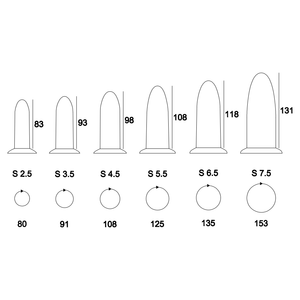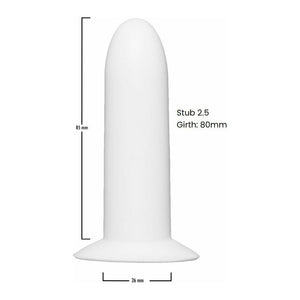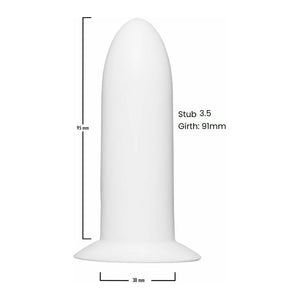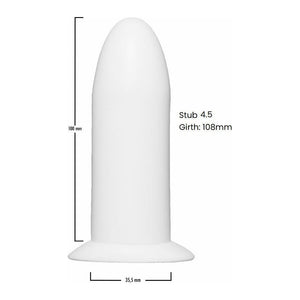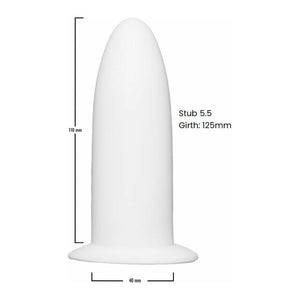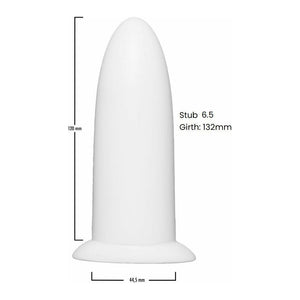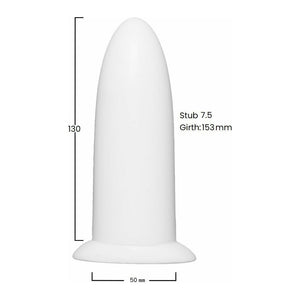Stub Dilators - wearable dilators
The
stub dilators are custom made for patients who prefer to "wear" the dilators during the day or at night to facilitate prolonged stretching and relaxation of the muscles.
The diameters are the same as that of the original dilators, we have just shortened them to make them more comfortable to wear.
Please allow up to two weeks for delivery as each order is custom made.
Stub dilators: What do the MSH doctors say?
"No 3 is the minimum size dilator you need to get to in order to be able to have a pap smear done with a small speculum by an experienced practitioner. If you can get to the number 4 dilator, it will be much easier."
"It is just in a different class than the commercially available plastic or glass dilators out there, and MUCH more affordable than the other silicone dilators because we manufacture them in South Africa."
In its manufacturing, the highest quality material available for this purpose has been used: SORTA-Clear 40, a body-safe silicone rubber with Shore A hardness of 40 and exceptional tear and tensile strength.
This product is not mass produced but individually casted and cured around an encased core or ‘spine’ to enhance its rigidity but retain its soft tip.
After manufacturing, each product is sterilised by My Sexual Health using medical autoclaves, and is individually packaged before being supplied to patients. Keep each dilator sealed in its sterile packaging until you use it.
For personal use, they can be cleaned with white normal soap, or the soap from the FEMAGENE range, and warm water, rinsed and dried thoroughly before stored in a cool, dry place.
Products with manufacturing flaws should be returned to My Sexual Health for a replacement.
WHEN IS THE USE OF VAGINAL DILATORS RECOMMENDED?
Dilator therapy is used for a range of pelvic floor problems including:
-
Shortened or narrowed vaginal canal after gynaecological surgery like hysterectomies and bladder lifts.
-
Pelvic floor muscle spasm (increased pelvic floor muscle tension or overactive pelvic floor muscles).
-
Reduced vaginal elasticity due to cancer and radiotherapy, with narrowing and adhesion in patients who had uterus, cervix, anal or rectal cancer.
-
Dyspareunia or difficult/painful intercourse – the most common cause we see is primary or secondary provoked vestibulodynia which is caused by hormonal imbalances, the pill, menopause, recurrent infections, a too tight pelvic floor and in some cases it is genetic.
-
Vaginismus or involuntary/painful pelvic floor spasm with attempted vaginal penetration.
-
Unconsummated marriages where couples need to be guided to a place where they will be able to penetrate for the first time.
-
Psychological problems and sexual health issues associated with vaginal penetration, for instance women who have not had sex for a prolonged period and would just like to make sure that they are still able to accommodate penetration.
-
Congenital abnormalitieswhere a neo vagina had to be formed.
-
Transgender women with neo vaginas that need to be dilated regularly.
-
Virginswho are about to get married and know that penetration will probably not be possible (especially if they are not able to comfortably insert a tampon).
-
Vulvodyniapatients who use it to relax their pelvic floors in order to decrease the tension on the nerves causing the pain.
-
Dermatological conditions like Lichen Sclerosis and Lichen Planuswhere there is narrowing of the vaginal opening and/or canal.
-
A Partner with an abnormally large penis,where it is necessary for the women to first stretch the vaginal walls and muscles around it before she can allow pain-free penetration.
-
Lesbian couples who would like to incorporate a form of penetration into their sexual play, but find it physically or psychologically difficult to insert something into the vagina.
BENEFITS OF DILATOR THERAPY:
When used appropriately, potential benefits of dilator therapy can include:
- Improved physical comfort with sexual intercourse after pelvic floor surgery with scarring and narrowing and/or shortening of the vagina.
- Allowing pain-free sexual penetration by training pelvic floor musclerelaxation.
- Reducing pelvic floor muscle tension or spasm in general.
- Overcoming a fear of vaginal penetration.
- Prevention of adhesion/fibrosis from forming during and after pelvic radiotherapy.
- Allowing for use of tampons.
- Facilitating ease of gynecological examination.
After a period of painful (or even impossible) intercourse, you have to teach your brain that you can allow something to go into your vagina without hurting you. The dilators help you with the process of systematic desensitisation on a physical and psychological level to get you to your goal.
How to progress to intercourse:
Once you can insert the number five (5) dilator without physical or emotional discomfort, we recommend that you involve your partner in the process. Only when your partner can insert the number five (5) dilator without causing discomfort for you, you can progress to attempt penetration as if your partner is the next dilator (rather than through a passionate love-making session). We find that it is better if you take the first few attempts at penetration very slow and then progress to normal intercourse when you are comfortable with penetration.
If you do not progress with your dilators, please see one of the MSH Doctors. They often use Botox to relax the muscles in certain cases where physiotherapy and dilator therapy have not given the desired results.
But does it work?
According to the statistics from our clinic, patients on average progress to between the no. 4 and 5 dilator within 3 to 4 weeks, if they take the prescribed medication and see the physiotherapist. Those who don’t, may need Botox (about 1/20) or more intensive psychological treatment.
PS: The vibrators in the image is not included, it is to illustrate size only
